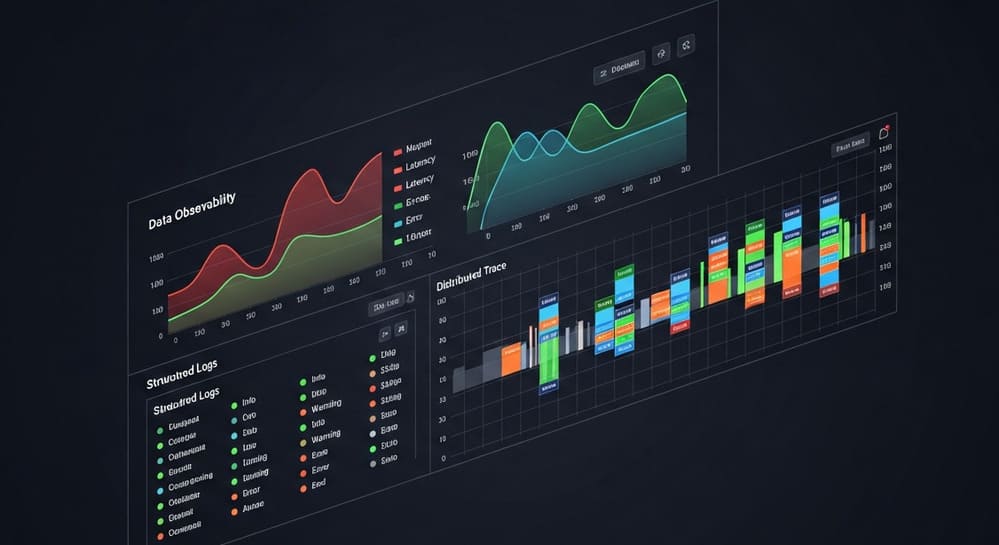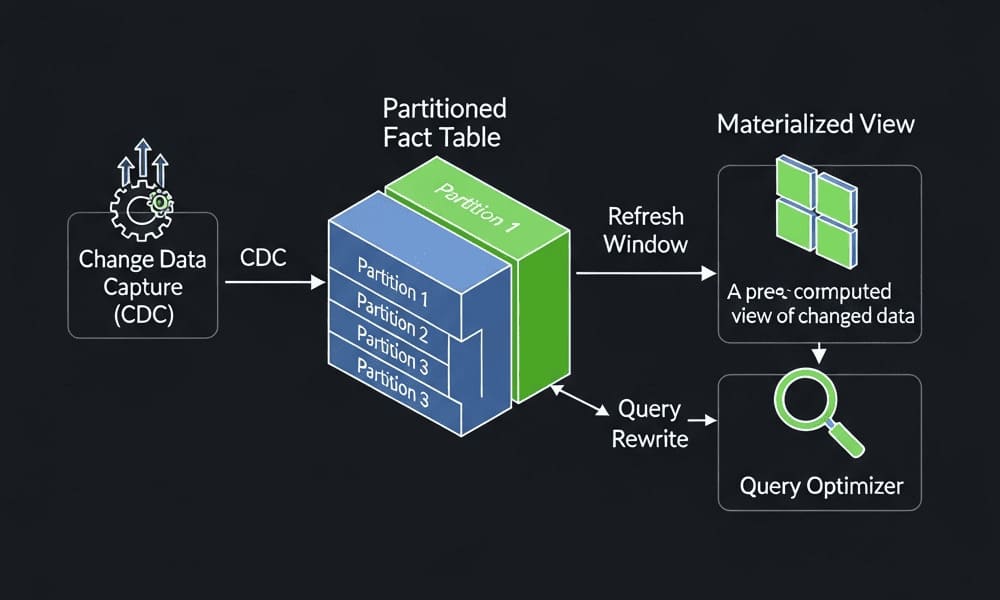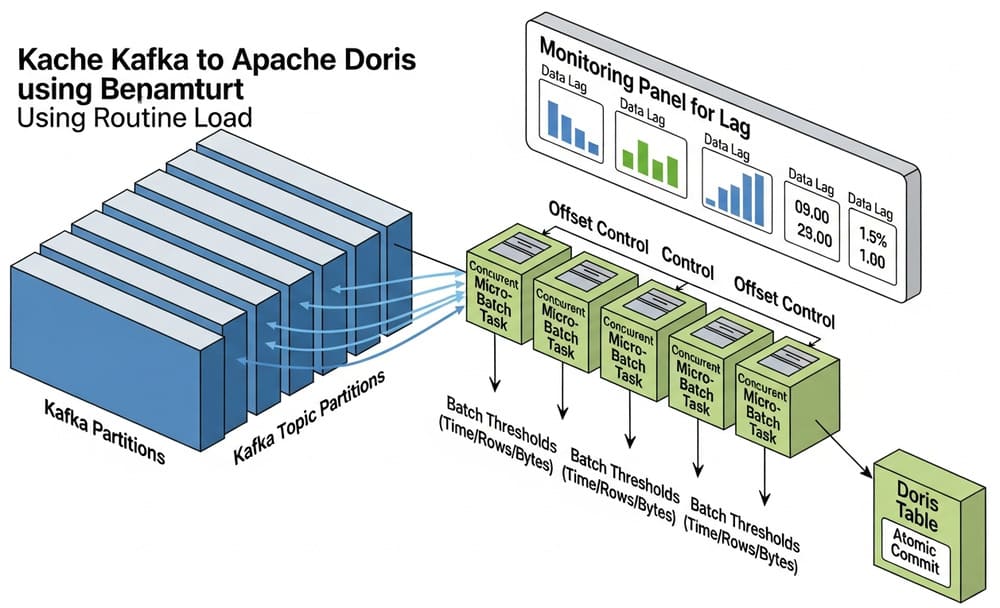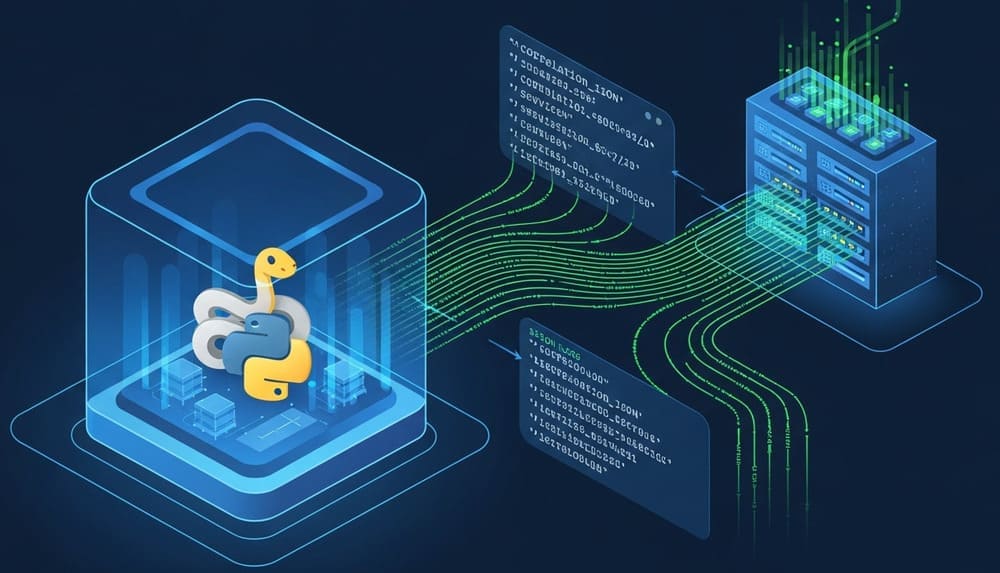Apache Flink for Data Engineers: Real-Time Streams Without the Hand-Waving
If your dashboards are always “five minutes behind,” batch jobs keep stepping on each other, or your “real-time” pipeline is just micro-batching in disguise, you need Flink. Apache Flink gives you true event-time processing, large managed state, and exactly-once guarantees—so fraud rules trigger now, not next hour.
Why Flink matters (and when it doesn’t)
Flink shines when you need:
- Low latency (10s of ms to seconds), not minute-level batches.
- Event-time correctness with late data handling.
- Huge stateful ops (joins, aggregations, CEP) at scale.
- End-to-end exactly-once with Kafka, object stores, and lakehouse tables.
Don’t pick Flink if all you need is a nightly rollup, or if your team can’t support always-on streaming ops yet.
Core concepts (architectural map)
Event time, watermarks, and windows
- Event time = when an event actually happened.
- Watermarks model “how far along” you are in event time; control lateness.
- Windows (tumbling, sliding, session) group events by event time.
State and checkpoints
- Flink keeps operator state (e.g., keyed aggregates) in a state backend (RocksDB or heap).
- Checkpoints (frequent, incremental) enable fault recovery.
- Savepoints (manual) let you upgrade jobs without data loss.
Exactly-once
- Implemented via checkpoint barriers and two-phase commits to sinks.
- Works with Kafka, many JDBC sinks, and lakehouse formats via connectors (Iceberg/Hudi/Delta).
APIs
- SQL/Table API for declarative analytics and CDC joins.
- DataStream API for full control of state, timers, and custom operators.
- PyFlink exposes SQL, Table, and (increasingly) DataStream for Python users.
Deployment
- Standalone/Kubernetes/YARN, or managed (e.g., Amazon Kinesis Data Analytics for Apache Flink, Ververica Platform).
- Scale via parallelism; rescale with savepoints.
Quick start: “from Kafka to Iceberg with exactly-once” (SQL)
-- 1) Source: Kafka orders
CREATE TABLE orders_raw (
order_id STRING,
user_id STRING,
amount DECIMAL(10,2),
ts TIMESTAMP(3),
WATERMARK FOR ts AS ts - INTERVAL '10' SECOND
) WITH (
'connector' = 'kafka',
'topic' = 'orders',
'properties.bootstrap.servers' = 'kafka:9092',
'value.format' = 'json',
'scan.startup.mode' = 'latest-offset'
);
-- 2) Sink: Iceberg table (append or upsert w/ primary key)
CREATE TABLE dim_daily_revenue (
day DATE,
revenue DECIMAL(18,2)
) PARTITIONED BY (day)
WITH (
'connector' = 'iceberg',
'catalog-name' = 'hadoop_prod',
'catalog-type' = 'hadoop',
'warehouse' = 's3://lake/warehouse/'
);
-- 3) Transform: event-time windowed aggregation
INSERT INTO dim_daily_revenue
SELECT
CAST(TUMBLE_START(ts, INTERVAL '1' DAY) AS DATE) AS day,
SUM(amount) AS revenue
FROM orders_raw
GROUP BY TUMBLE(ts, INTERVAL '1' DAY);
- Watermark tolerates 10s of out-of-order events.
- Iceberg keeps snapshots and ACID guarantees for downstream analytics.
DataStream example: keyed state + timers (Java)
DataStream<Event> events = env
.fromSource(kafkaSource, WatermarkStrategy
.<Event>forBoundedOutOfOrderness(Duration.ofSeconds(10))
.withTimestampAssigner((e, t) -> e.getTs()), "orders");
events
.keyBy(Event::getUserId)
.process(new KeyedProcessFunction<String, Event, Alert>() {
private ValueState<BigDecimal> running;
private ValueState<Long> timer;
public void open(Configuration c) {
running = getRuntimeContext().getState(
new ValueStateDescriptor<>("sum", BigDecimal.class));
timer = getRuntimeContext().getState(
new ValueStateDescriptor<>("timer", Long.class));
}
public void processElement(Event e, Context ctx, Collector<Alert> out) throws Exception {
BigDecimal sum = Optional.ofNullable(running.value()).orElse(BigDecimal.ZERO).add(e.getAmount());
running.update(sum);
if (timer.value() == null) {
long fireAt = ctx.timerService().currentProcessingTime() + 60_000;
ctx.timerService().registerProcessingTimeTimer(fireAt);
timer.update(fireAt);
}
if (sum.compareTo(new BigDecimal("5000")) > 0) {
out.collect(new Alert(e.getUserId(), "Spending spike"));
}
}
public void onTimer(long ts, OnTimerContext ctx, Collector<Alert> out) throws Exception {
running.clear(); timer.clear(); // reset every minute
}
})
.sinkTo(alertsSink);
- Shows keyed state, processing-time timers, and a rolling threshold alert.
PyFlink snippet: simple SQL job
from pyflink.table import EnvironmentSettings, TableEnvironment
t_env = TableEnvironment.create(EnvironmentSettings.in_streaming_mode())
t_env.execute_sql("""CREATE TEMPORARY VIEW metrics AS
SELECT window_start, window_end, COUNT(*) AS cnt
FROM TABLE(TUMBLE(TABLE source_table, DESCRIPTOR(ts), INTERVAL '1' MINUTE))
GROUP BY window_start, window_end
""")
Use PyFlink when your team is Python-heavy but still wants Flink SQL/Table power.
Flink vs the usual suspects
| Capability | Flink | Spark Structured Streaming | Kafka Streams |
|---|---|---|---|
| Latency | ms–seconds | seconds–minutes (micro-batch by default) | ms–seconds |
| State size | Very large (RocksDB) | Good (state store), but micro-batch overhead | Moderate (RocksDB) |
| Event-time / watermarks | First-class | Good | Basic |
| APIs | SQL/Table, DataStream, CEP | SQL/DataFrame | Java/Scala DSL |
| Exactly-once end-to-end | Yes (2PC) | Yes (to many sinks) | Yes (within Kafka) |
| Connectors | Broad (Kafka, JDBC, S3, Iceberg, Hudi, Delta, Pulsar, etc.) | Broad | Kafka-centric |
| Ops model | Always-on jobs | Micro-batch or continuous | Embedded apps |
If you need rich event-time semantics + huge state + many sinks, Flink is the pragmatic choice.
Best practices (that save you outages)
- Design around access patterns
- Model streams and keys according to the joins/aggregations you must run.
- Avoid “catch-all” topics that force expensive shuffles.
- Pick the right watermark strategy
- Start with bounded out-of-orderness (e.g., 10–120s).
- Measure late event rate; tune allowed lateness and side outputs.
- Manage state deliberately
- Default to RocksDB for large state; heap state for low latency + small state.
- Size pod memory & disk IOPS for RocksDB; watch compaction metrics.
- Checkpoints, not afterthoughts
- Interval: 10–120s; exactly-once sinks need stable checkpointing.
- Use externalized checkpoints and practice recovery.
- Backpressure visibility
- Enable backpressure sampling; widen bottleneck operators (parallelism) first.
- Watch busy time, mailbox throughput, GC, and network buffers.
- Schema & CDC discipline
- Use Debezium/Flink-CDC for source-of-truth changes.
- Enforce schema evolution rules; validate in a staging job.
- Safe upgrades with savepoints
- Take a savepoint, deploy new code, resume from savepoint.
- Keep operator UIDs stable to preserve state mapping.
- Partition wisely
- Avoid hot keys (e.g., celebrity user). Salt keys or use load-aware partitioning.
- Align Kafka partitions with Flink parallelism to minimize skew.
- Test with deterministic replays
- Keep a small Kafka topic (or files) as a replayable fixture for CI.
- Validate watermarking, late data behavior, and exactly-once idempotency.
- Choose the simplest API
- Prefer Flink SQL/Table for analytics and joins.
- Drop to DataStream only when you need custom state/timers/CEP.
Common pitfalls (learned the hard way)
- Treating processing time as event time. Your alerts will be wrong during spikes.
- Over-wide windows. Massive state + slow checkpoints = timeouts.
- Ignoring RocksDB I/O. Under-provisioned disks → backpressure chain reactions.
- Unstable operator UIDs. You’ll “lose” state on redeploy.
- Non-idempotent sinks. Exactly-once in Flink won’t save a side-effect-only HTTP sink.
Real-world pattern: dedup + sessionization → Iceberg
Use-case: Web events arrive out of order; you need per-user sessions and deduped pageviews.
Plan:
- Kafka → Flink SQL
- Dedup by
(user_id, page_id, ts)using primary key table or LAST_VALUE over window. - Session windows with
SESSION(ts, INTERVAL '30' MINUTES). - Write to Iceberg (partition by
date(ts)), then query with Trino/Spark for BI.
Why Flink: Event-time sessions with late data + exactly-once into lakehouse.
Internal link ideas (add these on your site)
- “Kafka Exactly-Once vs At-Least-Once: What Actually Breaks”
- “Designing Watermarks: Tuning Late Data Without Dropping Revenue”
- “Iceberg vs Delta vs Hudi: Choosing Your Lakehouse Table Format”
- “CDC with Debezium + Flink: Blueprints and Failure Modes”
- “Streaming Joins 101: When to Pre-Aggregate vs Full State Joins”
Conclusion & takeaways
- Flink = real real-time: event time, watermarks, and large state with exactly-once.
- Start with SQL/Table; reach for DataStream when you need precise state/timers.
- Engineer for state + I/O: RocksDB tuning, checkpoint stability, and backpressure are table stakes.
- Upgrade safely with savepoints and stable operator UIDs.
- If you only need hourly aggregates, don’t over-engineer—batch is fine.
Call to action: Want a production-ready Flink template (Kafka → Flink SQL → Iceberg) with CI replay tests and Terraform/K8s manifests? Say “Flink starter” and I’ll drop it in.
Image prompt
“A clean, modern data architecture diagram illustrating an Apache Flink streaming job reading from Kafka, performing event-time window aggregations with watermarks, and writing exactly-once to an Iceberg table in a data lake — minimalistic, high contrast, 3D isometric style.”
Tags
#ApacheFlink #StreamProcessing #DataEngineering #Kafka #Iceberg #RealTimeAnalytics #ExactlyOnce #EventTime
ApacheFlink, StreamProcessing, DataEngineering, Kafka, Iceberg, RealTimeAnalytics, ExactlyOnce, EventTime




